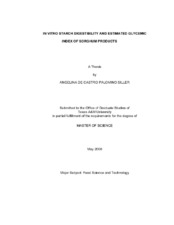| dc.description.abstract | Fractions from white and tannin sorghums were processed into extrudates, thick porridges, and breads. The effects of sorghum type and fraction on the in vitro starch availability of the products were evaluated, and the estimated glycemic indexes (EGI) of the products were obtained. Sorghum extrudates were significantly more slowly digested than corn meal extrudates for all preparation methods (whole, cracked and decorticated kernels). Furthermore, tannin extrudates were less digestible than white sorghum extrudates. The soft endosperm nature of the tannin sorghum limited friction formation inside the extruder, reducing starch gelatinization. On the other hand, condensed tannins also interfered with the starch availability for digestion. White sorghum was more 'suitable' for extrusion, giving extrudates with higher starch degradation and expansion than the tannin sorghums. However, tannin sorghums also gave acceptable products offering the benefit of lower EGI values. Sorghum porridges were more slowly digested than a corn flour porridge when using whole and decorticated flours. In addition, tannin sorghum porridges had a lower starch digestibility compared to all the samples. Tannin sorghum flours produced soft porridges with enhanced initial starch digestibility. However, condensed tannins seemed to offset the starch digestion by limiting starch availability. All sorghum porridges had significantly lower EGI values than the corn porridge. Extrudates and porridges had reduced starch digestibilities and EGI values when using whole grains compared to using the decorticated fractions. This was observed in both the white and the tannin sorghum. Therefore, whole-grain products from sorghum have health benefits attributed to whole grain foods and slower digesting starches; for instance, prevention and treatment of diseases such as diabetes, insulin resistance, obesity, cardiovascular disease, and some types of cancer. When 12% of tannin bran was added to a wheat bread formulation, a slower rate of starch digestion was observed compared to a wheat bread. The high concentration of non-starch components of the bran (i.e. dietary fiber, condensed tannins) affected starch digestion. The addition of tannin sorghum bran significantly reduced the EGI value of wheat bread, besides being a natural source of brown color, and an excellent source of antioxidants and dietary fiber. | en |


